Intel Beast Canyon NUC Review: Desktop Tiger Lake Debuts in SFF Gaming Powerhouse
by Ganesh T S on July 29, 2021 9:00 AM EST- Posted in
- Systems
- Intel
- NUC
- Tiger Lake
- NUC11
- Beast Canyon
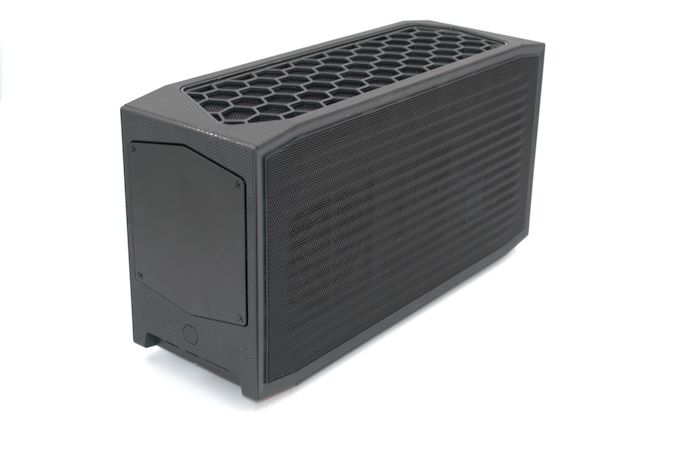
Intel kick-started a form-factor revolution in the early 2010s with the introduction of the ultra-compact NUCs. The systems were meant to be an alternative to the tower desktops used in many applications where the size, shape, and the system capabilities were mostly unwarranted. The success of the NUCs enabled Intel to start reimagining the build of systems used in a wider range of settings.
More recently, the introduction of the Skull Canyon NUC in 2016 was Intel's first effort to make a gaming-focused SFF PC. And desktop-focused Compute Elements (essentially, a motherboard in a PCIe card form-factor) launched in early 2020 meant that full-blown gaming desktops could credibly come under the NUC banner. Also last year, the Ghost Canyon NUC9 – the first NUC Extreme – made a splash in the market with support for a user-replaceable discrete GPU. Ghost Canyon was extremely impressive, but the restrictions on the dGPU size and high-end pricing were dampeners.
Thankfully, the introduction of Tiger Lake has enabled Intel to make multiple updates in its Compute Element lineup. Incorporating some tweaks and changes learned from their Ghost Canyon experience, Intel has now put forward its flagship NUC for 2021: Beast Canyon. With a desktop-class CPU and ability to accommodate most discrete GPUs in the market, the Beast Canyon NUC promises a lot. Does it manage to exorcise the ghosts of its predecessor? Our review below provides some answers.
Introduction and Product Impressions
Intel's lineup of gaming-focused NUCs started with the Performance series (Skull Canyon NUC6i7KYK and Hades Canyon NUC8i7HVK), before moving up the ladder to the Extreme series (Ghost Canyon NUC9i9QNX). The Beast Canyon, announced at the 2021 Computex, is taking over the flagship mantle this year. The important updates over the Ghost Canyon NUC include:
- Support for 65W desktop-class CPUs in the Compute Element (compared to the 45W mobile workstation-focused CPU in the Ghost Canyon's Compute Elements)
- Increased chassis dimensions to accommodate larger discrete GPUs
- 10nm Tiger Lake CPU with new micro-architectural improvements for performance and power-efficiency
- Support for a richer set of I/Os (including PCIe Gen 4)
Intel supplied us with an engineering sample of the high-end SKU in the Beast Canyon line - the NUC11BTMi9 sporting the NUC11 Extreme Compute Element (NUC11DBBi9). This Compute Element is housed in a 357mm x 189mm x 120mm chassis. Traditionally, NUCs have been associated with the ultra-compact form-factor (100mm x 100mm in a 0.63L or 0.42L chassis). The introduction of the Skull Canyon and subsequent Hades Canyon NUCs created yet another class of 0.7L to 1.2L NUCs, and last year's Ghost Canyon took it up to approximately 5L. The need to accommodate the cooling solution of a more powerful Compute Element, along with the ability to accept large dGPUs contribute to the 8L volume of the Beast Canyon NUC chassis. This is still within the realm of SFF PCs - an adult can still single-handedly carry the unit around. Other important SFF aspects such as the in-built PSU are carried over from the Ghost Canyon NUC.
Intel's NUC lineup has traditionally included board and kit variants, allowing its partners to provide value additions (such as a passive chassis or additional I/O ports in the end system). Kits (other than the ones that come with a pre-installed OS) require the end-user to add storage, DRAM, and install an OS to complete the system. Intel plans to sell two varieties of the Beast Canyon NUC - the NUC11BTMi9 and the NUC11BTMi7. These two NUCs are kits based on the Driver Bay line of Compute Elements. OEMs and end-users can build their own NUC11 system based on the following components:
- Compute Element (NUC11DBBi9 or NUC11DBBi7)
- Baseboard (or backplane)
- Chassis
- PSU
- DRAM (up to 2x DDR4-3200 SODIMMs)
- Non-volatile storage
- Discrete GPU (optional)
An off-the-shelf Beast Canyon NUC11BTM kit leaves only the DRAM, non-volatile storage, and discrete GPU to the choice of the end-user. Prior to the platform analysis and overview of our review configuration, let's take a look at the pre-decided components in the above list.
Driver Bay Compute Element
The NUC11BTMi9 we are reviewing today comes with the NUC11DBBi9 NUC11 Extreme Compute Element. It comes with a soldered processor - the Core i9-11900KB. This belongs to the Tiger Lake (11th Generation) family, and has a 8C/16T configuration with a 65W TDP. It can turbo up to 5 GHz. This Compute Element is a natural successor to the NUC9 Compute Element which re-imagined the traditional motherboard in a discrete PCIe x16 card form-factor.
The Compute Element comes with a cooling shroud containing a single fan and three M.2 heat-sinks with thermal pads pre-attached. These align with the three M.2 2280 slots in the Compute Element. The slot to the right of the processor is enabled by the x4 Gen 4 lanes directly from the processor, while the two to the right (and the M.2 slot occupied by the WLAN card) are from the PCH. On the extreme right, we have the two SODIMM slots that can operate at speeds of up to DDR-3200 for DIMMs up to 64GB in total. These are vertical slots (compared to the horizontal ones in the NUC9 Compute Elements), and free up valuable space that gets taken up by the extra M.2 slot. The gallery below provides additional photographs of the Compute Element and the cooling shroud.
The NUC11BTMi9 comes with two Thunderbolt 4 ports, a 2.5G Ethernet port, a HDMI 2.0a display output, and six USB 3.1 Gen 2 Type-A ports in the rear. There are two USB 3.1 Gen 2 Type-A ports, a 3.5mm stereo headset jack, and a SDXC slot with UHS-II support in the front. The front I/Os are enabled by a daughterboard that connects to the headers in the Compute Element. The Compute Element has its own power connection to the PSU.
Monster Cove Baseboard
The baseboard used in the Beast Canyon (code name Monster Cove) is an evolutionary update to the West Cove board used in the Ghost Canyon. The PCIe lanes are now Gen 4, but they retain the x8 / x4 / x4 bifurcation capabilities designed into the previous generation. Thankfully, the M.2 22110 slot resulting from this bifurcation is now easily accessible from the underside of the chassis, without having to take out the Compute Element from the baseboard.
Similar to the West Cove board, the usage of either of the two x4 slots hard-limits the peripheral in the x16 slot to x8 bandwidth. This was an issue in our review configuration of the Ghost Canyon NUC, but the Beast Canyon has no such issues, as discussed further below. One of the downsides of the new baseboard compared to the West Cove is the placement of the vertical x4 PCIe slot between the Compute Element slot and the x16 slot. Due to the placement of the air guide above the Compute Element's fan (essential due to the 65W TDP of the resident CPU), the x4 slot is rendered unusable.
Chassis and PSU
The NUC11BTMi9 chassis has the same ease of installation as the previous generation Extreme NUC. The dimensions have been expanded to allow the installation of dual slot GPUs up to 12" in length. The included 650W 80+ Gold internal PSU also supplies a 8-pin and a 2x6+2-pin connector for the GPU. The chassis can be disassembled by removing the four screws to dislodge the rear cover, and popping out the side panels.
The top panel with the three fans rests on a hinge. The embossed directions in the frame helpfully guide the user to open it up. This is essential to get access to the Compute Element and remove its shroud to install the RAM and storage.
Despite the plastic framing in the front panel, the metal-based construction in other areas gives the chassis a premium look and sturdy feel. The Beast Canyon NUC chassis also features customizable RGB underglow lighting, as well as replaceable RGB front logo. The chassis has ample space inside for easy cable management even in the presence of a discrete GPU. These are updates over the previous generation NUC Extreme.
The chassis also has a few downsides. The front USB ports are recessed, and given their Type-A nature, figuring out the correct orientation to plug in the peripherals is a bit of a hit or miss. Certain keyboard / mice receivers can end up being completely inside the recess, making it challenging to remove them when the other USB slot is also occupied. The placement of the PSU AC receptacle on the top end of the chassis means that the heavy AC power cord could potentially create cable management issues. In both these aspects, the Ghost Canyon NUC chassis had a much better design.
Our review sample of the NUC11BTMi9 came with the following components pre-installed:
- 2x Kingston HyperX KHX3200C20S4/8G for 16GB of DRAM
- 1x Sabrent Rocket NVMe 4.0 500GB M.2 2280 SSD
- ASUS Dual GeForce RTX 3060 12GB GDDR6
The presence of a desktop-class CPU in the system means that the Beast Canyon NUC should easily be able to support powerful GPUs such as the dual-slot RTX 3080 variants (even though we tested only with the RTX 3060). In the next section, we take a look at the full specifications of our review sample, followed by a detailed platform analysis along with some notes on our setup experience.


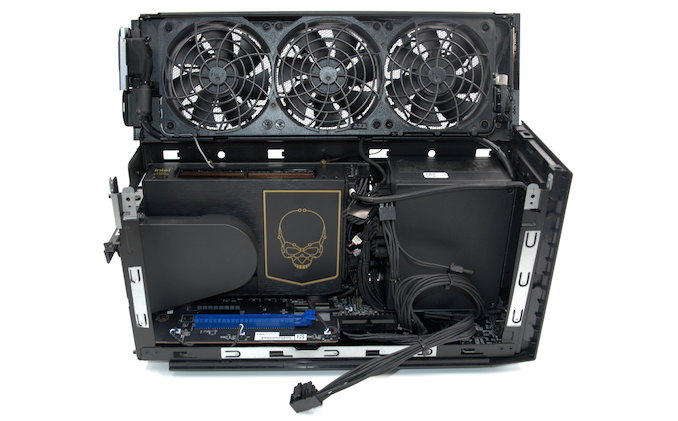
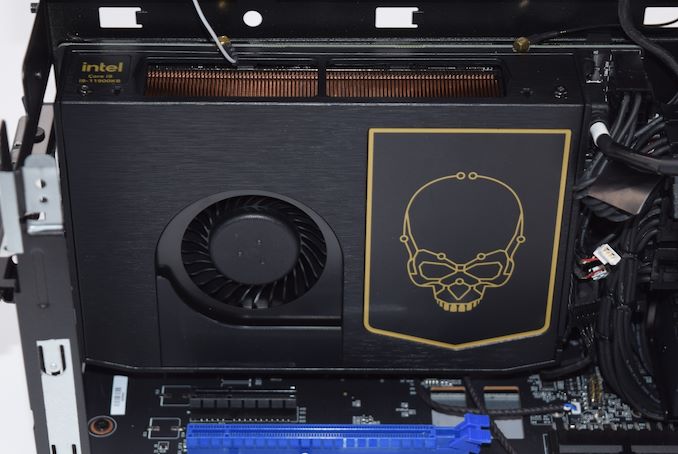





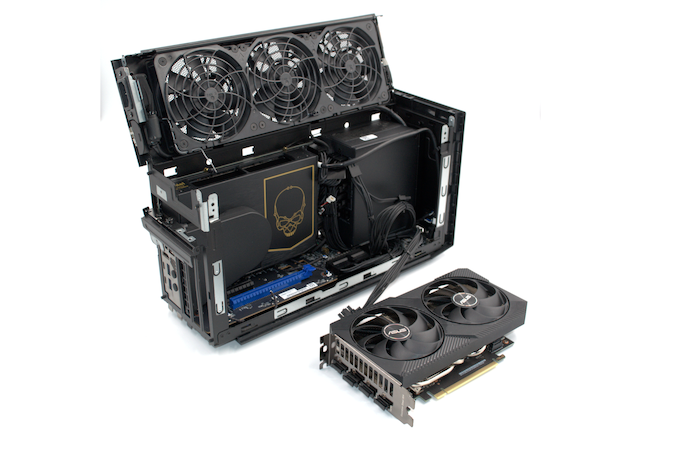
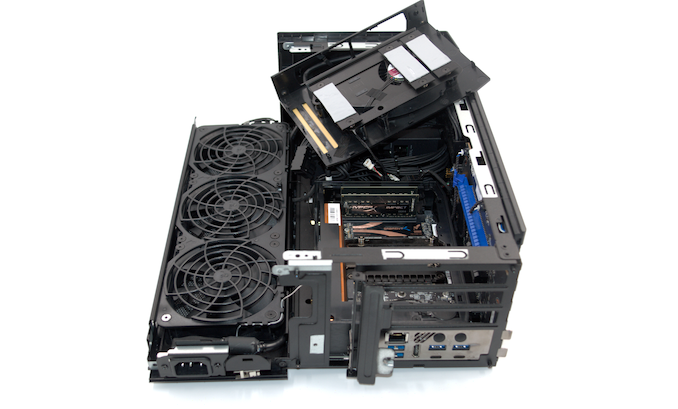








84 Comments
View All Comments
Spunjji - Friday, July 30, 2021 - link
"Can I buy the new compute element card and put it in a Ghost Canyon case?"I've been wondering that - I thought part of the point of the Element was to enable that sort of upgrade, but then I guess you'd lose the PCIe 4.0 compatibility
damianrobertjones - Friday, July 30, 2021 - link
Question: Can you purchase (I believe you can) JUST the element and place it into the previous model's chassis? That's what I was led to believe with this 'supposed' upgradability. If not, then possibly avoid this machine as there won't (probably) be an upgrade path. I did own the previous gen.Question 2: What the heck is going on with the smaller Nuc 11 units? I cannot seem to buy one ANYWHERE (u.k.).
mode_13h - Monday, August 2, 2021 - link
I think Tiger Lake is simply in high-demand. Intel likely prioritizes notebook OEMs above its own NUCs. Most NUC buyers probably don't know or care about the difference between 10th gen and 11th gen, so it's less bad to undersupply that market. Of course, this is all speculation.vol.2 - Tuesday, August 3, 2021 - link
I'm assuming they use the cheapest fans they can get away with. I'm sure the noise would improve dramatically if you replaced them with some better ones.Oxford Guy - Wednesday, August 11, 2021 - link
I’m sure the laws of physics are malleable.JoeDuarte - Tuesday, August 3, 2021 - link
1. It would help to benchmark them with more realistic specs, and consistent specs across the different SFF computers you included. 16 GB of RAM is too little for something this high-end, with an 8-core i9 Tiger Lake CPU, and a new-gen Nvidia 3060 GPU. (And you had 32 GB of in the Zotac...) 512 GB of SSD is too small for this kind of build, and there are big differences in SSD performance between 512 GB units and 1 TB+ sizes. (And you have different SSD models and sizes across the tested computers, ruining the validity of the results.)2. Intel's prices are still a bummer. I love the idea of a NUC, and of these X Canyon big-NUCs, but their prices and availability have always ruled them out. It's just worth it for what you get. We have to add several hundred dollars to that $1,350 price for this model. And hundreds more for a display, keyboard, and mouse. It's easily a $2,000 build, probably more like $2,300, all before taxes.
It makes more sense to go to PCPartPicker and build out a compact PC using one of those cuboid cases. They're a lot bigger than NUCs, but much smaller than mid-towers.
3. Intel really struggles with naming and model numbers. The NUCs are a messy jumble of letters and digits. And Intel commits the sin of having multiple names for the same thing, and you have to keep track of numerous confusing terms and their relation to each other. e.g.:
-- Goldmont vs. Apollo Lake, using Skylake arch, vs. Braxton vs. Willow Trail
-- Cherryview vs. Cherry Trail vs. Airmont
-- Beast Canyon vs. Bean Canyon vs. NUC vs. NUC11BTMi9
-- NUC11BTMi9 vs NUC11DBBi9, where the former is supposed to be a computer and the latter is a "Compute Element"
Nothing about the substring BTMi9 screams "computer", and nothing about the substring DBBi9 screams "Compute Element". It's all such a mess, and it makes it hard to shop for and buy Intel's products. If you don't already know the exact model number of what you want, there's no way to know from the model numbers that you encounter what you're getting or where it fits into the larger context of NUC models. These are things that any organization should be able to fix – clean, consistent naming, and clean, concise, and non-ugly model numbers.
mode_13h - Wednesday, August 4, 2021 - link
> It makes more sense to go to PCPartPicker and> build out a compact PC using one of those cuboid cases.
Except you cannot buy a Tiger Lake-H CPU. They're only sold in BGA and mostly found in laptops.
Unlike the Gemini/Jasper/Elkhart Lake CPUs (which are also BGA and often found in Chromebooks), you probably can't buy a mITX motherboard with them pre-installed, either.
JoeDuarte - Thursday, August 12, 2021 - link
I didn't think of that, though it wouldn't matter in my case. Whenever I build out a system at PCPartPicker I choose the Core i7-11700 or one of the Zen 3 chips – I think it's called a 5600 or 5800, but I forget. I don't think Tiger Lake-H would be an improvement from those, just maybe lower power.The GPUs are decent for integrated, and that has made me lean toward Intel because of the difficulty in finding current gen discrete GPUs like the 3060 Ti, but I haven't pulled the trigger yet. The Zen 3s don't have integrated GPUs, which would leave me without a GPU unless I settled for an obsolete 1650 or something. I'd rather live with the Intel 750 for a spell until the powerhouses are available at normal prices.
mode_13h - Friday, August 13, 2021 - link
> I choose the Core i7-11700 ... I don't think Tiger Lake-H would be an improvement> from those, just maybe lower power.
There are some notable differences. The desktop 11th gen CPUs are Rocket Lake, built on Intel's 14 nm++++ process, using Cypress Cove cores. Those cores are a 14 nm back-port of Ice Lake's (launched in 2019) Sunny Cove.
The Laptop & NUC 11th gen CPUs are Tiger Lake, which use Intel's 10 nm+++ node (also called 10 nm SF). They use Willow Cove cores, which are a generation newer than Ice Lake's (and therefore Rocket Lake's). However, the generational gains of the cores were modest, with the main difference being that Tiger Lake clocks higher.
Now, if you want to compare spec-for-spec, try this:
https://ark.intel.com/content/www/us/en/ark/compar...
The main thing that shows is that Tiger Lake-H has 50% more cache and the top-end model clocks lower. However, being a laptop chip, the top-end model also has a TDP of just 65 W. So, it's probably better to compare it with the fastest 65 W Rocket Lake:
https://ark.intel.com/content/www/us/en/ark/compar...
According to that, Tiger Lake-H is able to offer a much better Base clock, though its turbo is still lower. That's probably because its peak power is also lower, again being a laptop chip. Furthermore, clock speeds don't tell the whole story. In the end, specs are no match for actual benchmarks:
https://www.tomshardware.com/news/intels-enthusias...
These benchmarks show Rocket Lake pulling ahead in GPU tests, probably due to its faster turbo. However, when it comes to CPU-intensive tests, we see Tiger Lake hold its own.
Unfortunately, not many people seem to have run that exact comparison. Most are either comparing with the top Rocket Lake SKU or just other SFF PCs. If anyone else has benchmarks of the i9-11900KB vs. i9-11900, please share.
I guess the point is that if you care about power/noise/size, this NUC Extreme seems pretty compelling. If you're willing to spend a bit more and go for a top-of-the-line desktop, then you should probably fare better with Rocket Lake.
I wish Tiger Lake-H came in a LGA-1200 socketed version, so we could really see it stretch its legs. I'll bet it would beat even i9-11900KF by a noticeable amount.
> The Zen 3s don't have integrated GPUs
They do now! Check out the new Ryzen 5000G models!
https://www.anandtech.com/show/16824/amd-ryzen-7-5...
They're decent, for an integrated GPU, but not on par with the RTX 3060 in this NUC Extreme.
mode_13h - Wednesday, August 4, 2021 - link
> And Intel commits the sin of having multiple names for the same thing,> and you have to keep track of numerous confusing terms and their
> relation to each other. e.g.:
>
> -- Goldmont vs. Apollo Lake, using Skylake arch, vs. Braxton vs. Willow Trail
> -- Cherryview vs. Cherry Trail vs. Airmont
Goldmont is the core. Apollo Lake is the SoC. The "Mont" cores are the low-power ones. They've been very consistent about that: Silvermont, Airmont, Goldmont, Goldmont+, Tremont, and soon Gracemont.
Starting with Ice Lake, the big cores are named after coves, so far.
And the "Trail" names seem to be system designs, or something?
The one naming convention that really got out of control is the "lakes". Those seem to have very little consistent meaning. I think they have a few Lakes that aren't even CPUs/SoCs.
> Nothing about the substring BTMi9 screams "computer"
It's just a model number, dude. Just type it into a search engine and look it up. And some places I've seen will at least say it's a NUC compute element, although that requires you to know how one differs from a regular NUC.
> It's all such a mess
I will agree that Intel's product line is full of subtle variations, like NUCs with one vs. two Ethernet ports. I was staring at two Tiger Lake NUC listings, trying to figure out the difference, until I noticed that.